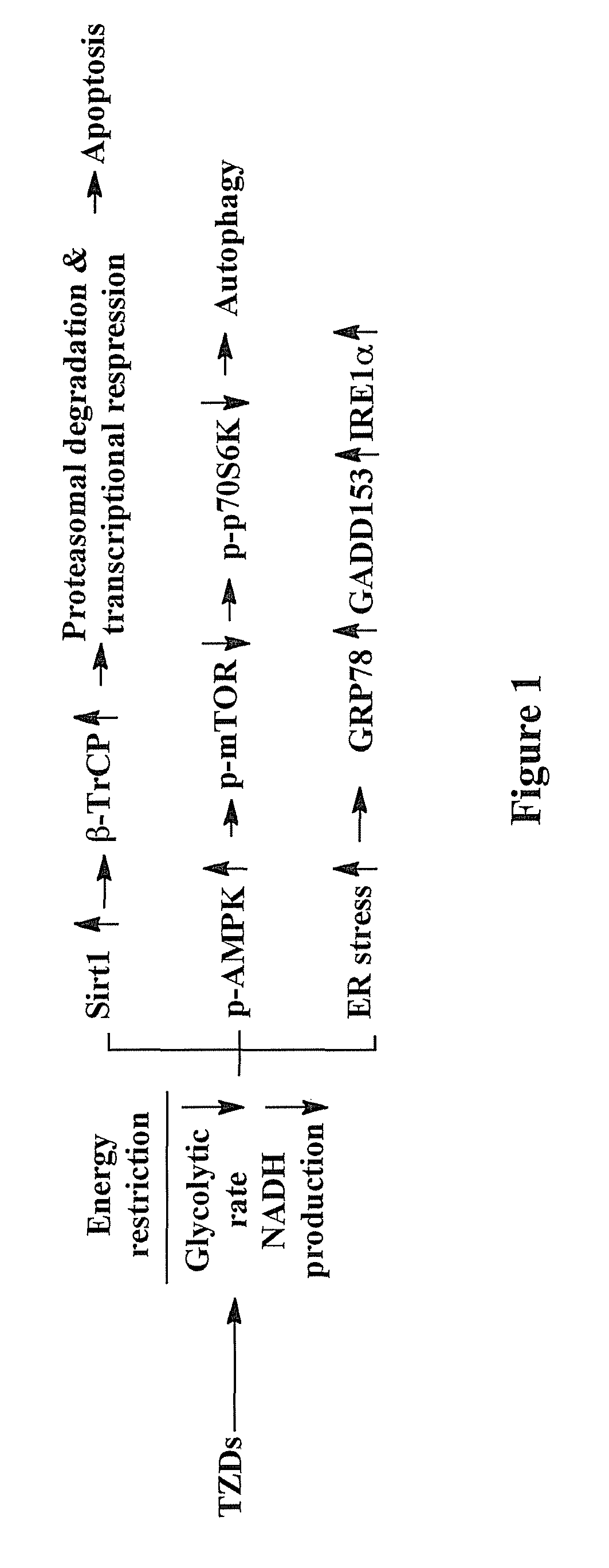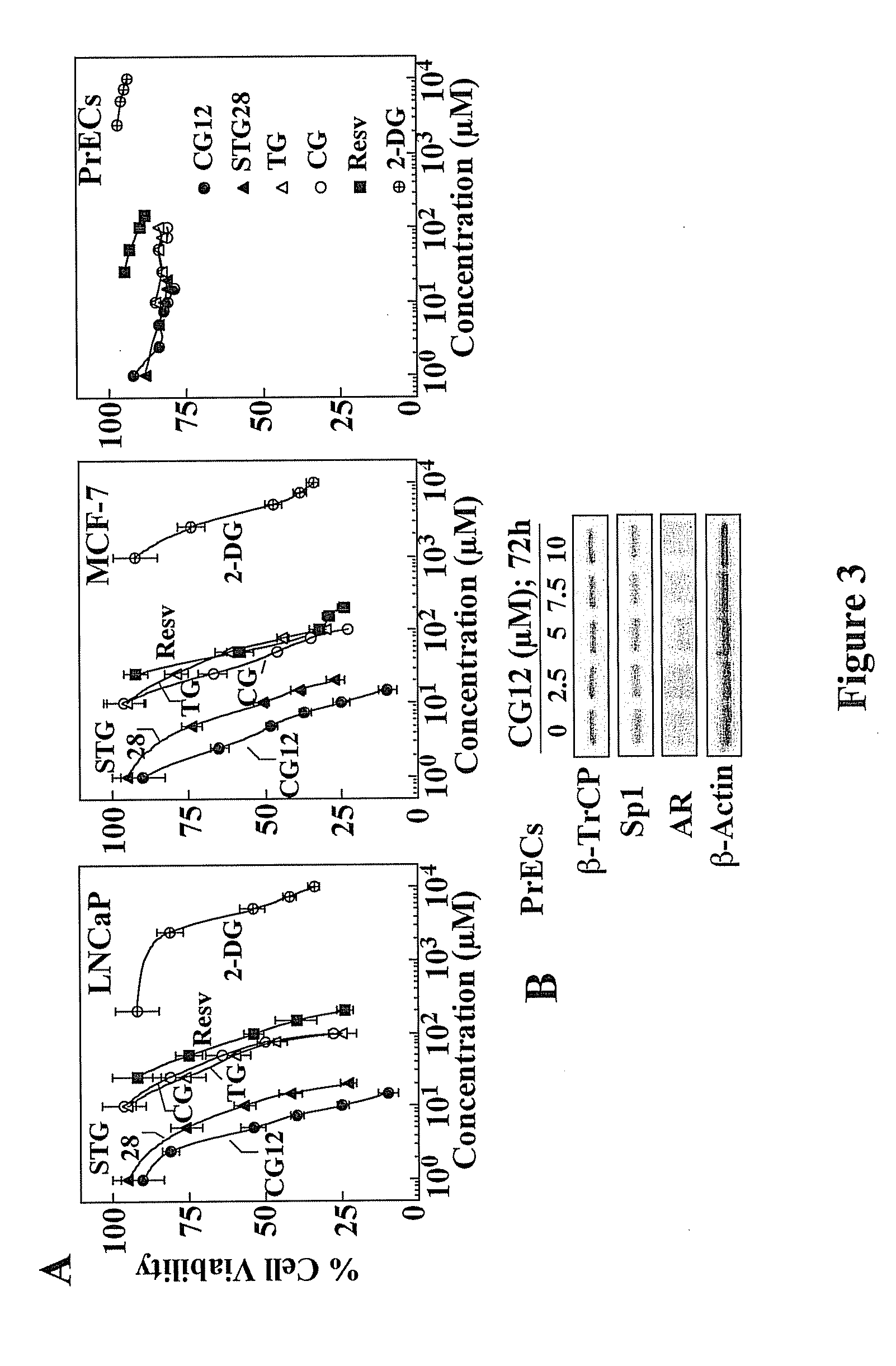Thiazolidinedione energy restriction-mimetic agents
a technology of thiazolidinedione and energy restriction, which is applied in the direction of metabolism disorder, drug composition, immunological disorders, etc., can solve the problems of restricted therapeutic applications of these agents, and achieve the effect of increasing the longevity of a subj
- Summary
- Abstract
- Description
- Claims
- Application Information
AI Technical Summary
Benefits of technology
Problems solved by technology
Method used
Image
Examples
example i
Effect of Thiazolidinedione Compounds on Energy Restriction in Cancer Cells
[0175]In this example, the inventors demonstrate that troglitazone, ciglitazone, STG28, and OSU-CG12 were able to elicit hallmark cellular responses characteristic of energy restriction in LNCaP prostate cancer and MCF-7 breast cancer cells. These energy restriction-associated changes include reduced glycolytic rate and NADH and lactate production, transient induction of silent information regulator 1 (Sirt1) gene expression, and activation of the intracellular fuel sensor AMP-activated protein kinase (AMPK) and endoplasmic reticulum (ER) stress, the interplay among which culminates in autophagy and apoptosis. The implications of this finding are multifold. First, it provides a molecular basis to use TZDs as a scaffold to develop potent energy restriction-mimetic agents, as demonstrated by the identification of OSU-CG12 as a potent energy restriction mimetic agent. OSU-CG12 exhibits potency in mediating starv...
example ii
Ability of Thiazolidinedione Derivatives OSU-CG5 and OSU-CG12 to Suppress Cancer Cell Growth Per the NCI 60 Cell Line Screening Analysis
[0217]The National Cancer Institute carried out experiments to evaluate the anticancer activity of OSU-CG5 and OSU-CG12 against a variety of different cancers using various different cell lines. For a review of the NCI60 screening method, see Shoemaker, R. H., Nature Reviews, 6: p. 813-823 (2006). More specifically, OSU-CG5 and OSU-CG12 were tested for their ability to inhibit the growth of prostate cancer, breast cancer, leukemia, non-small cell lung cancer, colon cancer, CNS cancer, melanoma, ovarian cancer, and renal cancer cell lines. A variety of different cell lines were used to evaluate the inhibition of each type of cancer. For example, CCFR-CEM, HL-60, K-562, MOLT-4, RPMI-8226, and SR cell lines were used to evaluate the effect of OSU-A9M on leukemia. The data from these experiments demonstrated that both OSU-CG5 and OSU-CG12 exhibited sign...
example iii
Development of Novel Adenosine Monophosphate-Activated Protein Kinase Activators
[0222]In light of the unique ability of the thiazolidinedione family of PPARγ agonists to mediate PPARγ-independent activation of AMPK, the inventors hypothesized that these agents could be pharmacologically exploited to develop potent AMPK activators by dissociating these two pharmacological activities. A two-tiered screening of an in-house, thiazolidinedione-based focused compound library was carried out to identify novel agents that, at low μM concentrations, exhibited the ability to activate AMPK and to inhibit IL-6 production independently of PPARγ in human THP-1 macrophages.
[0223]To abolish the PPARγ activity of the thiazolidinediones, the inventors used the unsaturated derivatives of troglitazone and ciglitazone 61 (Δ2TG) and 62 (Δ2CG) as scaffolds to develop a focused compound library consisting of 60 compounds (1-60; FIG. 13). Cell-based assays pertinent to the activation status of AMPK and mTOR...
PUM
| Property | Measurement | Unit |
|---|---|---|
| volumes | aaaaa | aaaaa |
| concentrations | aaaaa | aaaaa |
| concentrations | aaaaa | aaaaa |
Abstract
Description
Claims
Application Information
 Login to View More
Login to View More - R&D
- Intellectual Property
- Life Sciences
- Materials
- Tech Scout
- Unparalleled Data Quality
- Higher Quality Content
- 60% Fewer Hallucinations
Browse by: Latest US Patents, China's latest patents, Technical Efficacy Thesaurus, Application Domain, Technology Topic, Popular Technical Reports.
© 2025 PatSnap. All rights reserved.Legal|Privacy policy|Modern Slavery Act Transparency Statement|Sitemap|About US| Contact US: help@patsnap.com



